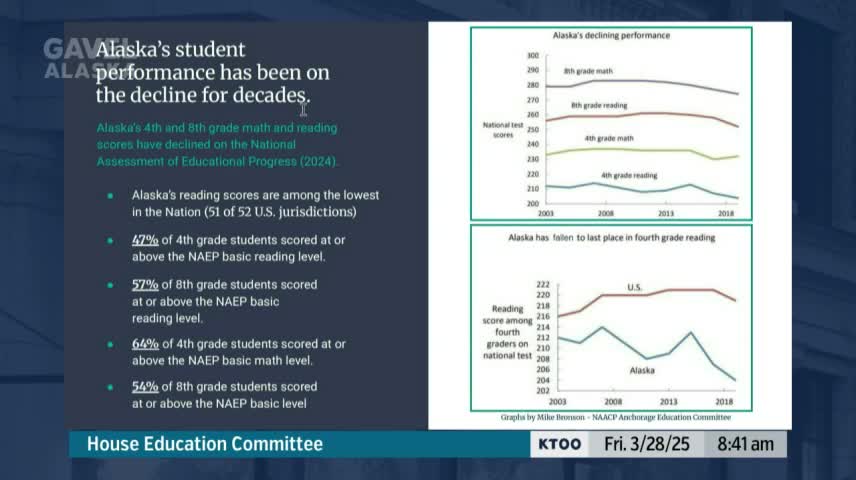Anchorage School District considers new bill for reducing class sizes amid funding challenges
March 28, 2025 | 2025 Legislature Alaska, Alaska
This article was created by AI summarizing key points discussed. AI makes mistakes, so for full details and context, please refer to the video of the full meeting. Please report any errors so we can fix them. Report an error »

A significant shift in Alaska's education policy was discussed during the House Education Committee meeting on March 28, 2025, focusing on the urgent need to address rising class sizes in schools. Lawmakers highlighted a troubling correlation between increasing class sizes and declining student performance, as evidenced by National Assessment of Educational Progress (NAEP) scores.
The proposed legislation aims to replace the traditional pupil-teacher ratio (PTR) metric with a more direct measure of class size. Advocates argue that while PTR provides some insight into staffing levels, it can obscure the reality of overcrowded classrooms. For instance, a school may appear adequately staffed if it includes librarians in its calculations, but this does not alleviate the burden of large class sizes on students.
The bill proposes a class size limit of 24 students, a compromise that reflects financial constraints while aiming to improve educational outcomes. Research, including the well-regarded Tennessee STAR study, supports the notion that smaller class sizes significantly enhance student achievement, particularly for disadvantaged learners. The study suggests that optimal class sizes of 15 students in early grades can lead to substantial academic benefits.
Lawmakers acknowledged the challenges posed by years of underfunding in education, which have contributed to the current situation of large class sizes in Anchorage schools. They emphasized that students in overcrowded classrooms face long-term academic and social repercussions, underscoring the urgency of the proposed changes.
The discussion also touched on the broader context of class size negotiations in other states, where teacher unions often prioritize class size in collective bargaining agreements. This highlights a growing recognition of the importance of manageable class sizes for both student success and teacher retention.
As the committee considers the bill, there is a call for further amendments to gradually phase in lower class sizes, aligning with evidence-based recommendations for a high-performing educational system. The outcome of this legislation could have lasting implications for Alaska's students and educators, shaping the future of education in the state.
The proposed legislation aims to replace the traditional pupil-teacher ratio (PTR) metric with a more direct measure of class size. Advocates argue that while PTR provides some insight into staffing levels, it can obscure the reality of overcrowded classrooms. For instance, a school may appear adequately staffed if it includes librarians in its calculations, but this does not alleviate the burden of large class sizes on students.
The bill proposes a class size limit of 24 students, a compromise that reflects financial constraints while aiming to improve educational outcomes. Research, including the well-regarded Tennessee STAR study, supports the notion that smaller class sizes significantly enhance student achievement, particularly for disadvantaged learners. The study suggests that optimal class sizes of 15 students in early grades can lead to substantial academic benefits.
Lawmakers acknowledged the challenges posed by years of underfunding in education, which have contributed to the current situation of large class sizes in Anchorage schools. They emphasized that students in overcrowded classrooms face long-term academic and social repercussions, underscoring the urgency of the proposed changes.
The discussion also touched on the broader context of class size negotiations in other states, where teacher unions often prioritize class size in collective bargaining agreements. This highlights a growing recognition of the importance of manageable class sizes for both student success and teacher retention.
As the committee considers the bill, there is a call for further amendments to gradually phase in lower class sizes, aligning with evidence-based recommendations for a high-performing educational system. The outcome of this legislation could have lasting implications for Alaska's students and educators, shaping the future of education in the state.
View full meeting
This article is based on a recent meeting—watch the full video and explore the complete transcript for deeper insights into the discussion.
View full meeting
